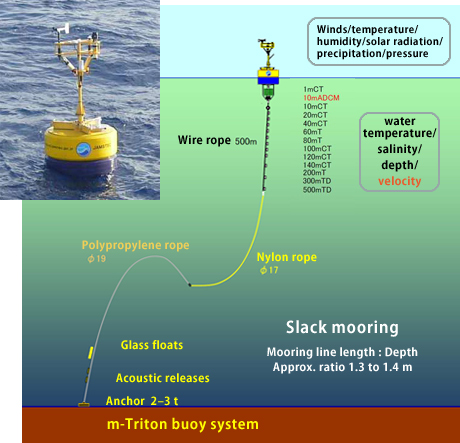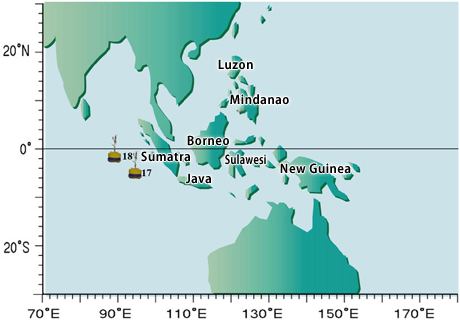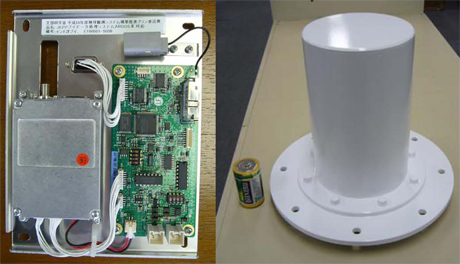
April 13, 2009
Japan Agency for Marine-Earth Science and Technology
JAMSTEC Achieves World’s First High Data Rate Transmission via ARGOS-3
~Opens New Avenues for Science including Climate Research ~
1.Overview
The Japan Agency for Marine-Earth Science and Technology (JAMSTEC: Yasuhiro Kato, President) has achieved the world’s first high-speed data transmission by AROGOS-3 System (*1), using a transmitter called PMT-HD (Platform Message Transceiver High Data Volume) (*2). The AROGS-3 compatible transmitter, developed by JAMSTEC and exclusively designed for ocean observation, was integrated into an m-TRITON buoy system (Fig.1). The buoy was deployed in the eastern Indian Ocean (1.5 degrees South, 90 degrees East) from the JAMSTEC research vessel KAIYO during its cruise from March 10 to 31, 2009 (Fig.2).
The transmission system with the PMT-HD, which can provide a two-way communication and high data-rate uplink, has enabled real-time transfer of data, allowing greater efficiency in data acquisition. Such enhancements are expected to lead to a wider and more effective use of buoy data, offering more possibilities in various fields of science, including climate variations.
This project is funded by the Ministry of Education, Culture, Sports, Science and Technology of Japan, and being conducted as part of the “Japan Earth observation system Promotion Program (JEPP).”
2.Background
JAMSTEC has been operating ocean observation mooring buoys in the equatorial waters of the western Pacific and the eastern Indian Oceans, using the conventional ARGOS system for data transmission. However, due to a limited capacity of data transmission, it has not been possible to transmit all observation data. Instead, the mean values of the data were transmitted at certain intervals. Therefore, the detailed observational data that were accumulated inside the buoy was acquired only after the recovery of the buoy, approximately one year after the deployment.
In order to eliminate such time lag, JAMSTEC began to develop the PMT-HD transmitter in cooperation with a Japanese manufacturer of electronic and communication products, prior to the launching of the ARGOS-3 System.
3.Future perspective
The high-speed data transmission achieved by the PMT-HD can provide real-time and continuous observational data that has no missing values. This will enable the world’s scientists to perform detailed analyses on atmospheric-ocean phenomena on a shorter time scale.
The increased transmission capacity will also permit observations on chemical and biological aspects of the ocean, in addition to the conventional physical observations, offering a broad spectrum of applications in multiple domains of science.
Currently, two m-Triton buoys are operating in the Indian Ocean, and the third will start operation later this year. By equipping these buoys with the PMT-HD transmitter, JASMTEC will facilitate fast and reliable retrieval of invaluable data, thus contributing to a further progress in climate research in the Indian Ocean.
*1: Argos-3 system
The Argos-3 system was launched aboard the polar orbiting meteorological satellite MetOp-A in October 2006, by the European Organization for the Exploitation of Meteorological Satellites (EUMETSAT). The functions in use (a high-speed channel of 4.8 kbps and two-way communication) began operation in January 2008, which is capable of transferring 10 times more data than before. The downlink capability unique to Argos-3 allows it to send satellite’s orbit information to a transmitter and let it predict the next satellite pass, so that effective two-way communication can take place. The Argos-3 system also has an ability to perform error checks when messages are received by satellites, and sends back the results to the transmitter to confirm the transmission.
*2: PMT-HD (Platform Message Transceiver High Data Volume) for data buoy (Fig.3)
PMT-HD features the following functionality:
- the ability to accumulate data from buoys,
- the ability to synchronize data transmission with satellite flyovers,
- data verification with the satellite,
- detection of battery depletion and switching to backup battery.

Figure 1: Schematic sketch and pohoto of m-Triton buoy system

Figure 2: Locations of m-Triton buoys (No.18: PMT-HD equipped)

Figure 3: PMT-HD for data buoy (left: unit, right: antenna)
Contacts:
- (For the project)
-
Yasuhisa Ishihara
Department of Applied Ocean Engineering
Marine Technology Center (MARITEC)
Japan Agency for Marine-Earth Science and Technology
- (For Publication)
-
Noriyuki Murata, e-mail: press@jamstec.go.jp
Manager, Planning Department Press Office
Japan Agency for Marine-Earth Science and Technology